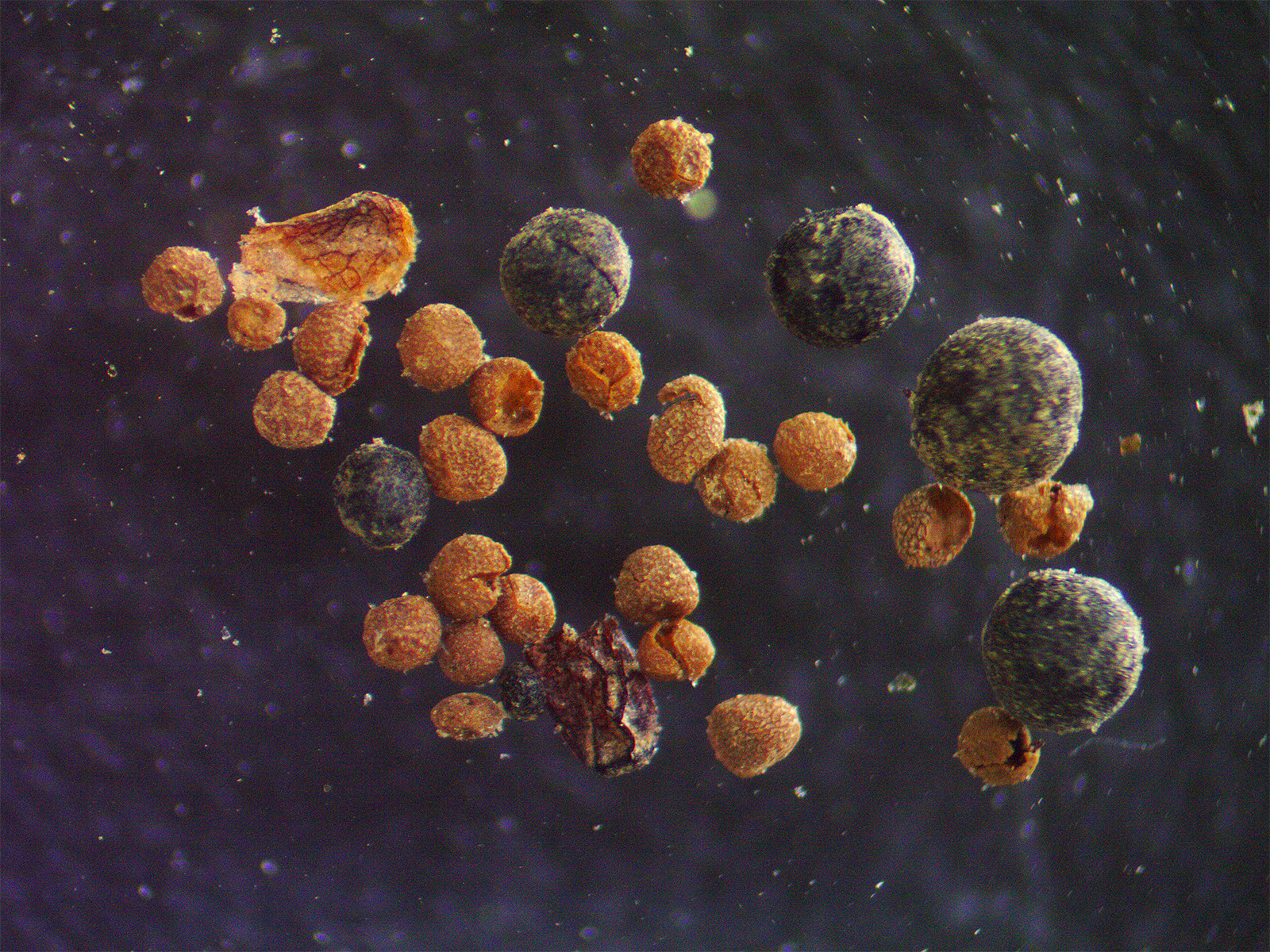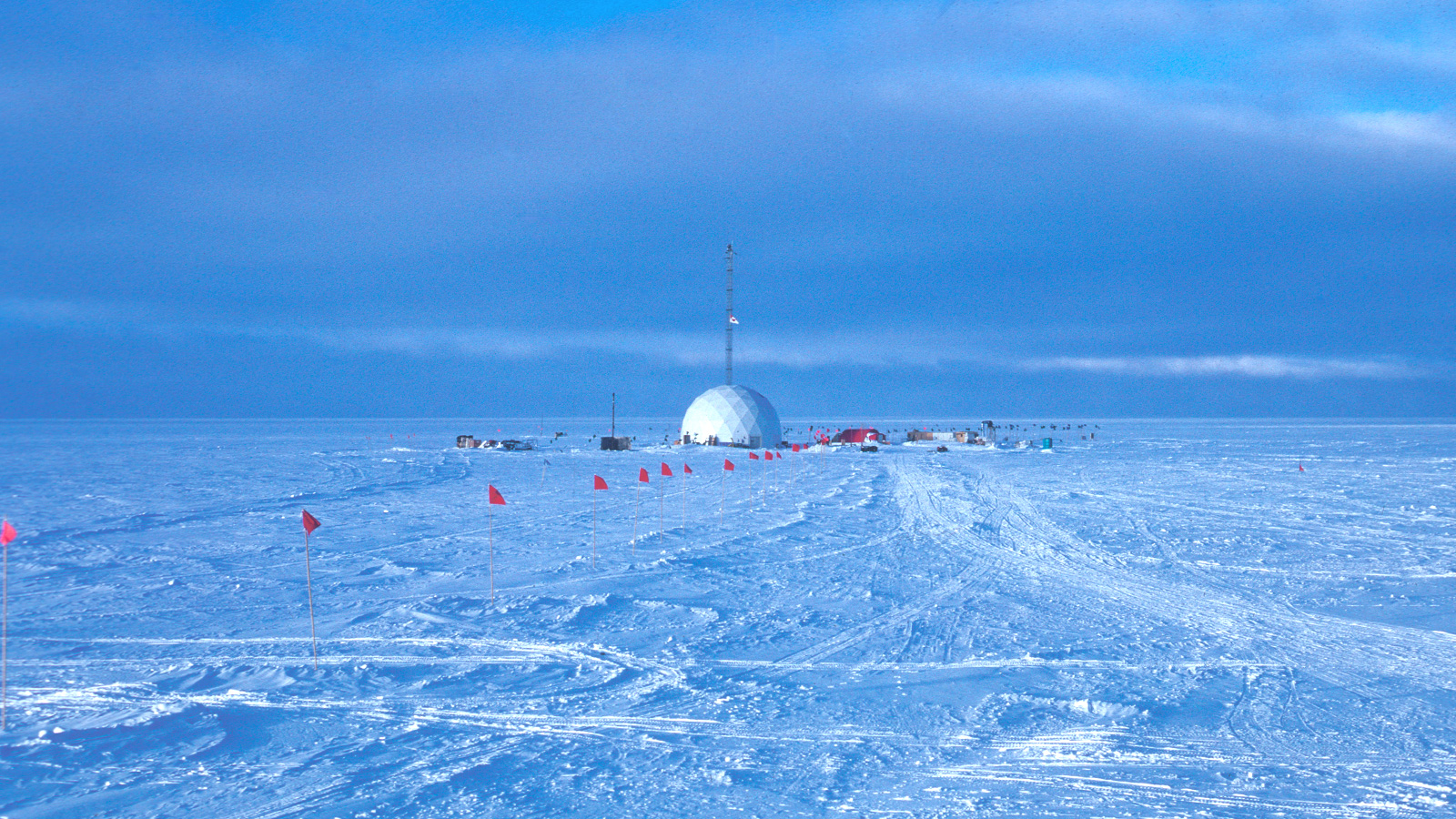Late on a Saturday afternoon in June 2022, Andrew Christ was on the verge of a discovery at the University of Vermont. A postdoctoral researcher studying the interactions between glaciers and landscapes at the time, Christ was rinsing a sample taken from the bottom of a 30-year-old ice core from the center of Greenland’s ice sheet — a mere 30 grams of mucky slush left behind from glaciers grinding against bedrock. As he watched, the sediment settled at the bottom of a plastic tub and small black flecks began to flutter in the water.
“Oh my god, I’ve seen this before,” Christ thought. He had observed a similar phenomenon in a sample from a different site his lab had been examining, but hadn’t been expecting to see it in the center of Greenland’s ice sheet. After peering at the specks through a microscope, he discovered that they were fossilized fragments of ancient poppies, insect parts, and tree bark — embodied memories of an ice-free Greenland, perfectly preserved in time.
This week, the University of Vermont team who analyzed this sample published a study concluding that the discovery of plant and insect life from the center of the continent indicates that the land held hardly any ice, or perhaps none at all, at some point in the 1.1 million years.
The new evidence that Greenland lived up to its verdant name in the not-so-distant past may represent an exciting scientific breakthrough, but it also heralds ominous possibilities for the future of humanity. Present-day atmospheric carbon dioxide levels are higher than they’ve been in millions of years; evidence of an ice-free Greenland in the more recent past means that it could take even less warming than once expected to deplete the continent’s all-important ice sheet. The frozen stronghold that covers Greenland contains enough fresh water to raise sea levels by 23 feet — a staggering volume that would reshape coastlines around the world.
As global temperatures surpass levels not seen for 125,000 years, that melt is already well underway. Since satellite records began in 1992, antarctic and arctic ice sheets have lost a staggering 7.5 trillion tons of ice combined. Less than a foot of sea level rise since the beginning of the century has already wrought flooding upon coastal communities around the world.
Predicting the future of ice sheets is tricky business. Scientists haven’t yet been able to make computer models that match up with the real-time melt they’re observing, leaving the world’s governments unsure of how much sea level rise to prepare for. But as a growing pile of evidence seems to suggest, what has melted once could melt again, leaving scientists worried that Greenland’s ice sheet is vulnerable enough to vanish completely.
“Studies like this are pretty rare because we just don’t have that much access to the bottom of the Greenland ice sheet,” said Tyler Jones, a glaciology researcher at the University of Colorado, of this week’s new research. (Jones was not involved with the University of Vermont paper, but he has studied temperature records in ice cores.) “It can really help us understand how it might behave in a future warmer world.”

Halley Mastro / The University of Vermont
For their study, the University of Vermont team started by requesting a sample of the sediment where the 1993 Greenland Ice Sheet Project 2, or GISP2, ice core hit bedrock — one of the few samples of its kind. It came from 2 miles beneath the ice and, along with the rest of the core, took five years of drilling to extract.
“Ice cores are amazing books, basically like an archive of Earth’s past,” said Halley Mastro, a graduate student who led the study along with Paul Bierman, a geology professor at the University of Vermont and the author of a forthcoming book on Greenland ice loss. According to Mastro, scientists have historically sought ice cores for the clean ice, where crystalline bubbles trap gases and chemicals indicative of past climate conditions.
“But what we have is 8 centimeters of dirt from the bottom — that was just not as big of a priority at the time,” she added.
Bierman thinks part of the reason his team was the first to find fossils is because ice core scientists are trained to look for chemical clues instead. But in 2019, while rinsing the sediment from the bottom of a core from Camp Century, a 1960s ice sheet boring site near the perimeter of the Greenland ice sheet, he saw familiar floating black flecks.
“Because I wasn’t trained as an ice core scientist, I had worked on lake sediment for the first 10 years of my career, and I knew how to find fossils,” said Bierman. “It was a completely lucky moment.”
In 2021, Bierman and Christ published their findings from Camp Century. Then, in 2023, they dated the fossilized vegetation they found to a mere 416,000 years ago — indicating that the edge of Greenland must have been ice-free then. Now, after finding fossils in the GISP2 core — which constitute evidence of a thriving tundra ecosystem in the center of Greenland as well — Bierman and Mastro think the continent as a whole was at least 90 percent ice-free sometime in the last 1.1 million years. As Mastro puts it, “No ice sheet would have a big hole in the middle.”
“If you find plants at the bottom, that means the ice is pretty much gone everywhere,” said Dorothy Peteet, a macrofossils expert who helped Mastro analyze the sample. The researchers found fragments of moss, fungus, a poppy seed, willow bark, and an insect eye and legs. According to Peteet, the fragility of these kinds of specimens makes the discovery especially remarkable: It means that as the glacier formed, it must not have moved very much, or it would have destroyed these fragments as it ground against the rock.
For Peteet, the most exciting part of the discovery is the comparison to today’s plants, and what that indicates about past climates. The presence of poppy seeds, for instance, could indicate that the continent enjoyed a balmy temperature average of roughly 40 degrees Fahrenheit, according to the paper.
“A certain fossil tells you that that plant was there, then you can really fingerprint the climate that it grew in based on a modern analog today,” she said.
Jones, the University of Colorado glaciologist, said that the new study points to the need for more research, given its potential implications for future ice loss.
“We’re going to create a planet that is warmer than any time in the last few million years at some point,” he told Grist. “Most likely, we’re creating a world where these ice sheets are going to melt.”
On the plus side, scientists may not have to wait another 30 years for more samples: Next year, a group of researchers from the Denmark Center for Ice and Climate have plans to return to an old ice core drilling site near the center of Greenland, just 19 miles from GISP2.
Meanwhile, in Jones’ view, the evidence suggests an urgent need to reduce greenhouse gas emissions and limit planetary warming and sea level rise.
“Once you melt that Greenland ice sheet, it’s irreversible,” he said. “It will not come back for a very, very, very long time.”

